Survey on disaster preparedness for cold seasons
Survey on disaster preparedness for cold seasons conducted among respondents who have and have not experienced evacuations during cold weather
Over 50% of respondents “have not prepared for disasters in winter!”
74% of evacuees said they needed hot water at evacuation sites
Tiger Corporation (President: Yoshisato Kikuchi, Headquarters: Kadoma City, Osaka), a world leader in thermal control technology, conducted an online survey between the 2nd and 5th of December regarding disaster preparedness during cold weather. The survey was conducted among 330 men and women in their 20s to 60s nationwide who have experienced earthquake evacuations during cold weather, as well as 330 people who have never experienced such a situation.
Among those who have experienced evacuations during cold seasons, 52% say they “have not prepared for disasters in winter,” while among those who have not experienced evacuations during cold season, the figure is 62%. With over half of both groups unprepared, the results indicate issues in disaster preparedness for the cold season. In addition, when asked the question, “What are some problems you faced/people face in evacuation shelters during the cold season?,” the top response by those who had not experienced evacuations was “feeling cold,” followed by “it’s too cold to sleep,” with “crowded bathrooms” ranking third. Among those who had experienced evacuations, the top response was “feeling cold,” followed by “lack of warm food,” with “not being able to take a bath” ranking third. While the top responses were the same, the following two responses differed, indicating a large gap between perception and reality in terms of the problems experienced in evacuations during cold weather. In addition to basic disaster preparedness, seasonal preparedness should also be considered necessary.
Current State of Disaster Preparedness
According to the 2021 White Paper on Land, Infrastructure, Transport and Tourism( * ), the number of respondents who “do nothing” to prepare for natural disasters has decreased from 52% before the Great East Japan Earthquake (surveyed around 2010) to 39% as of January–February 2021, indicating growing awareness about disaster preparedness. In addition, the percentage of people who “have prepared food, water and emergency bags” has increased from 22% to 35% over the past decade.
There has been in increase in the percentage of people who have made basic disaster preparations without taking into account the time of year. However, in Japan, where various disasters such as earthquakes, typhoons, and heavy rainfall are common, further measures that are specific to the time of year are necessary in seasons such as winter and summer. It is for this reason that Tiger Corporation conducted its survey on disaster preparedness for cold seasons.
*Source: White Paper on Land, Infrastructure, Transport and Tourism, 2021, Chapter 2, Section 2
https://www.mlit.go.jp/hakusyo/mlit/r02/hakusho/r03/pdf/np102200.pdf
Among both those who have and have not experienced evacuations during cold seasons, over half of respondents said they “have not prepared for disasters in winter.”
Among both those who have and have not experienced evacuations during cold seasons, a majority say they “have not prepared for disasters in winter,” indicating insufficient preparedness for disasters in cold weather.
By contrast, only 36.2% of those who have experienced evacuations during the cold season and 17.3% of those who have not experienced evacuations responded that they are “sufficiently prepared for disasters in winter,” indicating that the number of people who are prepared is 19% higher among those who have experienced evacuations in cold seasons. Based on these results, it appears that many people learned about the necessity of disaster preparedness for cold weather through the actual experience of evacuating during cold weather.
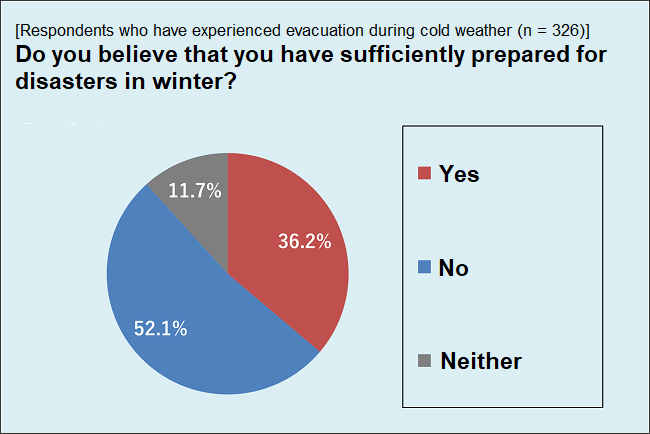
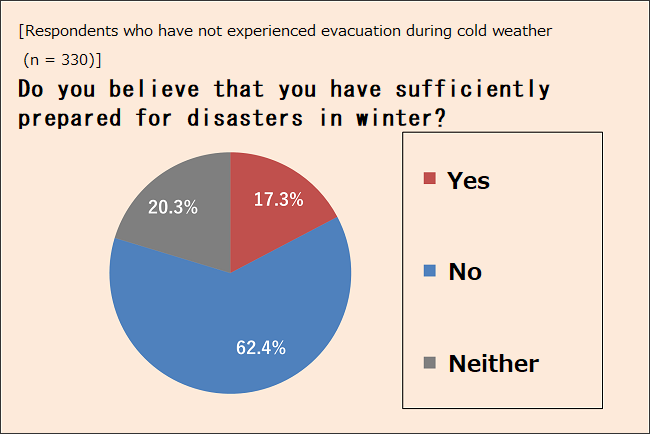
Warm drinks and warm rice are actually what people want during evacuations in the sold season
When asked the question, “What are some problems you faced/people face in evacuation shelters during the cold season?,” the top response by those who had not experienced evacuations was “feeling cold,” followed by “it’s too cold to sleep,” with “crowded bathrooms” ranking third. Among those who had experienced evacuations, the top response was “feeling cold,” followed by “lack of warm food,” with “not being able to take a bath” ranking third. While the top responses were the same, the following two responses differed, indicating a large gap between perception and reality in terms of the problems experienced in evacuations during cold weather.
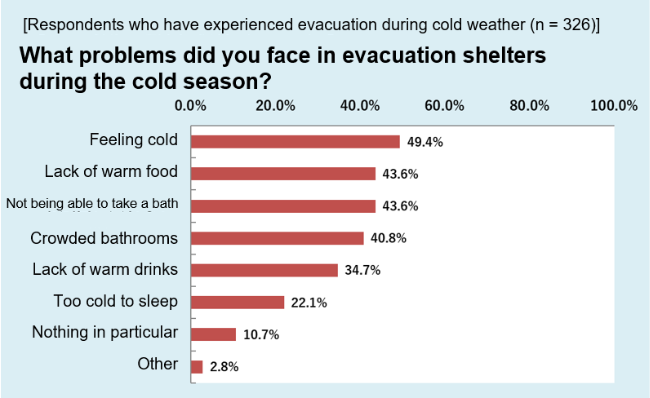
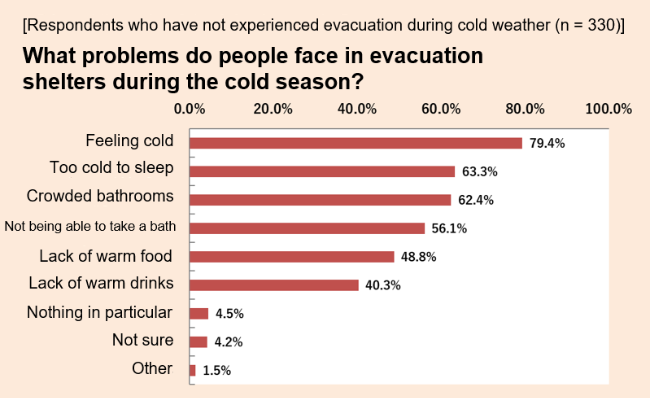
“Warm drinks (other than hot water)” topped the list of “things that would be good to have/things you wished they had at evacuation shelters during cold weather” for both those who have and have not experienced evacuations. On the other hand, there was a gap in the responses that followed. Those who have not experienced evacuations ranked “blankets” second and “cold protection sheets” third, while those who have experienced evacuations ranked “warm food” second and “blankets” third. We found that what is sought after in shelters during cold weather is warm food and beverages that can warm the body from the inside out.
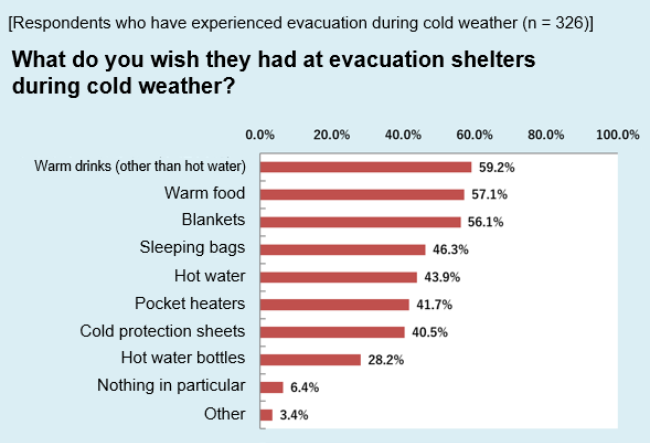
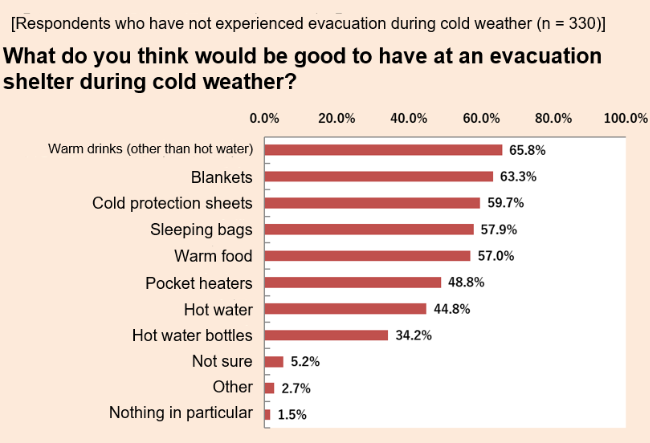
74% of evacuees said they needed hot water at evacuation sites
74% of those who have experienced evacuations during cold weather responded that they “needed hot water at an evacuation shelter during cold weather.” Among those who evacuated with their children, 88% say they “needed hot water at an evacuation shelter during cold weather.” In addition, approximately 83% of all respondents answered that they “think it would be good to have tools (thermos pots, water bottles, food jars, etc.) to keep hot water warm without electricity in evacuation shelters during cold weather.” In cold weather, when securing hot water is often a challenge, we found that there is a high need for vacuum insulated products that can retain hot water during evacuations.
Specifically, the three situations where hot water was most needed were “when having hot drinks” (64.2%), “when making instant noodles” (57.5%), and “when making instant soup” (38.3%). All of the situations when hot water was most needed were related to food and drinks. At 37.5%, “when making warm hand towels” also ranked high. When we asked those who had experienced evacuations about “problems they faced in evacuation shelters during cold weather,” the second most common response was “not being able to take a bath,” suggesting that many of them needed warm hand towels for self-care in place of a bath.
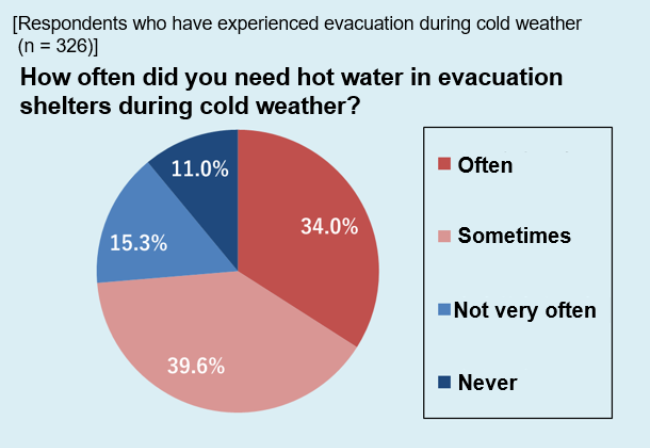
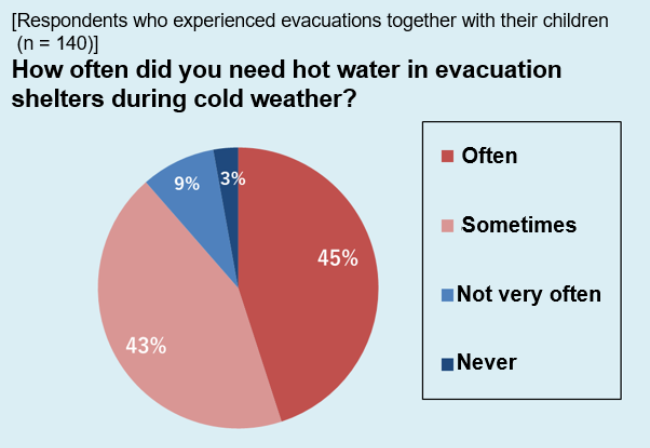
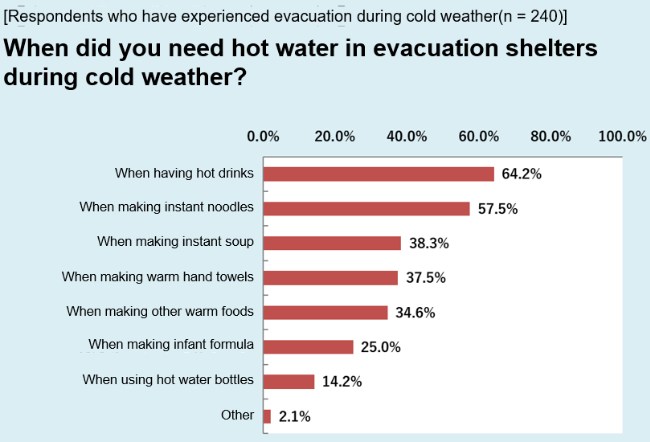
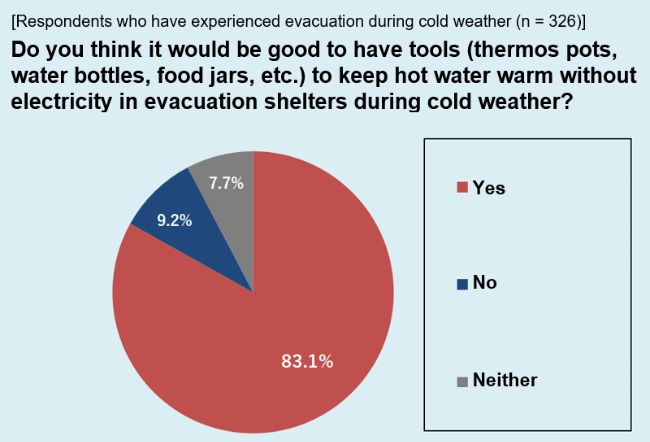
Survey Overview
- Survey Sample: Men and Women in their 20s to 60s
[Respondents who have experienced evacuation during cold weather] 330 people (326 valid responses)
[Respondents who have not experienced evacuation during cold weather] 330 people - Survey Period: December 2 (Fri)–December 5 (Mon), 2022
- Survey Method: Online survey (conducted by Tiger Corporation)
*If you cite any of the contents of this press release, please mention that the source is the survey conducted by Tiger Corporation.
Thoughts on Disaster Preparedness in Winter by Rika Horinaka, Disaster Preparation Storage Master Planner and Disaster Prevention Expert
Opinion on Findings
More than half of the respondents who have experienced evacuations and 62% of respondents who have not said that they are not prepared for disasters in winter. However, disasters during cold weather can lead to hypothermia, depending on your location and circumstances. There is a risk of losing your life. There is no region in Japan that is completely safe from disasters. I would like you to take this opportunity to prepare for wintertime disasters.
Three Ways to Use Hot Water in Disasters
Having hot water means you have access to hot food and drinks. It is recommended to prepare foods that can be eaten simply by adding hot water, such as alpha rice or instant soup. Alpha rice can also be eaten with water, but cold rice in a cold place is not very palatable and can be demoralizing. A cold belly can cause the entire body to become cold and make you feel unwell. Making the rice with hot water makes it easier to eat in proper amounts. Also, a warm, sweet drink is soothing in itself. It’s a good idea to prepare sweet drinks such as instant cocoa.
If you have a baby who needs milk, hot water is a must. I’ve heard many people who were affected by disasters say that they could not make milk because there was no hot water. Regularly keeping hot water in a stainless steel bottle is a good way to be prepared for emergencies, and being able to carry it with you brings peace of mind. Some electric water boilers don’t work when you press the button during a power outage, so I recommend having an electric water boiler that can produce water without electricity. Even if a baby bottle is not available, you can use a paper cup to feed your baby milk. They’re disposable, so there’s no need to worry about hygiene. You should get used to paper cups by using them on the go.
If you have warm water, a towel wrung out with hot water will be very handy. Not only can you use it to wipe your body, but massaging your head with the wrung out towel will also refresh your hair! Wiping your child’s face and hands will relax them and relieve tension. In times of disaster, stress can build up in unexpected ways. You can use a towel wrung with hot water to calm your mind.
What can be done in winter in terms of disaster preparations?
It’s a good idea to make a habit of boiling water and putting it in a bottle every night, just in case. Then, even if a disaster occurs in the middle of the night, you can use the hot water. For the sake of habit, I highly recommend hot water in the morning and evening. You can drink some before going to bed to replenish your fluids while you are sleeping, and you can drink some in the morning to warm your cold internal organs.
In terms of disaster preparations, it is convenient to have a heater that can be used even if electricity and gas are not available. For everyday use, I recommend an oil heater. If you can’t use kerosene because of your location or other reasons, a gas canister heater will also work. Like gas canister cooking stoves, they are fueled using gas canisters, which can be stored for long periods of time.
If you also have a gas canister cooking stove prepared, you can rest assured you will be able to make hot water. If you have a thermos kettle or stainless steel bottle handy when you make hot water, you will be able to save fuel. If you prepare heat-resistant plastic bags, you can use them to prepare warm food in a hot water bath. Various recipes are available, so I recommend these for daily use.
By incorporating disaster preparations into your daily life, they become easier to use in the event of an emergency. Please start by trying to incorporate one of these preparations into your daily life.

Rika Horinaka, President of Katazuke Kobito
Disaster Prevention Expert, Disaster Preparation Storage Master Planner, and Lifestyle UX Designer
Qualifications: Disaster prevention expert, disaster preparation storage master planner, organizational storage consultant, etc. Under the motto, “Why not raise a Katazuke Kobito (cleanup helper) for your home?,” she provides support for safe and secure living through organizational storage and disaster preparation storage. Her seminars on tidying and storing and emergency preparedness are popular, as well as her weekly online club, Minna de Okatazuke Club. Blog: How to Find Your Katazuke Kobito
Reference Information | Recommended Items Useful for Keeping Water Hot
Lightweight and compact bottles that fit neatly in emergency bags and are equipped with stoppers with an antibacterial finish
MMP-K021/031 and MMZ-K351/501/601 Vacuum Insulated Bottles
The 500 mL bottle, MMZ-K501, keeps the temperature of its contents above 74 degrees Celsius even after about 6 hours. ( * )
In addition, the gasket and inner plug are made with an antibacterial finish for hygienic use.
*The heat insulation effect is the temperature of water in a bottle 6 hours after the bottle filled with hot water at 95±1°C is placed in an upright position and left standing at a room temperature of 20±2°C.
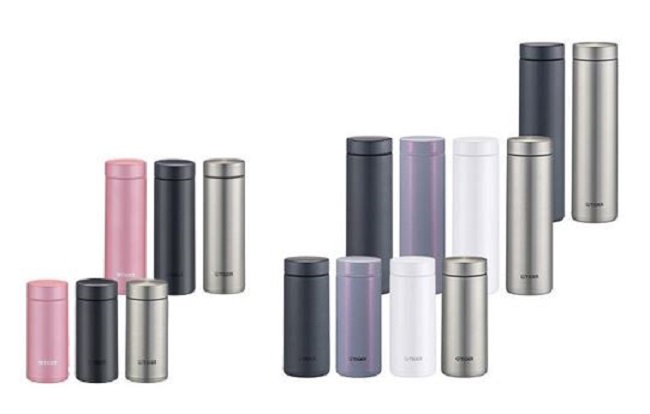
Keeps soup and rice warm in addition to water
MCL-B025/B030/B038 Vacuum Insulated Food Jars
The round shape of the bottom and the wide mouth with a diameter of approx. 7 cm makes it easy to scoop out the ingredients with a spoon.
In addition to hot water, these food jars are also useful for keeping instant soup and rice warm.
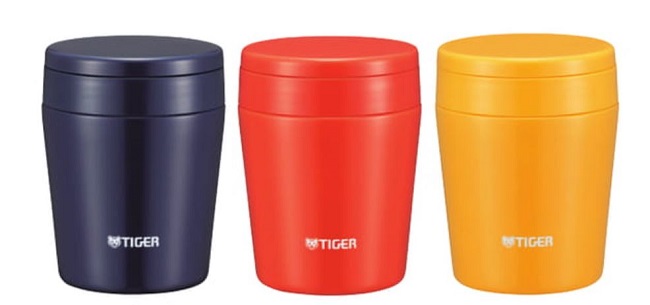
Easy-to-use warming pots with push levers
PWO-A 120/160/200 Vacuum Insulated Stainless Steel Pots
These stainless steel pots allow you to save energy by keeping drinks hot for a long time without using electricity.
They are available in 1.2 L, 1.6 L, 2.0 L sizes so you can keep plenty of water hot.
*The image shows the PWO-A160 (1.6 L size).
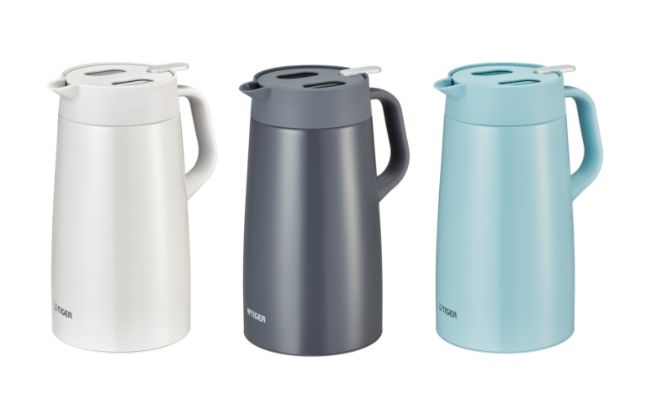
Watch a movie outlining Tiger Corporation’s vision statement for the next 100 years — “Do Hot! Do Cool!”

Tiger Corporation will mark its 100th anniversary in 2023.
Since our founding, we have continued to focus on advanced thermal control through the use of vacuum insulation and thermal control technologies.
We will continue to make the best use of these technologies to spread joyous harmony throughout the world for the next 100 years.
“Do Hot! Do Cool!” Bring warmth for 100 years. Act cool for 100 years.
Japanese : https://youtu.be/MQe_G1aveuM
English : https://youtu.be/imqk_PCEJt4